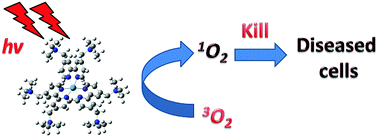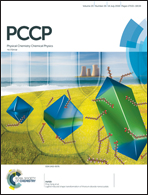Theoretical study on photophysical properties of three high water solubility polypyridyl complexes for two-photon photodynamic therapy†
Abstract
Two-photon photodynamic therapy (TP-PDT) is a very promising treatment that has drawn much attention in recent years due to its ability to penetrate deeper into tissues and minimize the damage to normal cells. Here, the properties of three highly water soluble Ru(II) and Zn(II) polypyridyl complexes as photosensitizers (PSs) were examined, including the one-photon and two-photon absorption (OPA and TPA) spectra, singlet–triplet energy gap (ΔH–L), TPA cross-section and spin–orbit coupling constant via Density Function Theory (DFT) and Time-Dependent Density Functional Theory (TD-DFT). Their potential therapeutic use as photosensitizers in TP-PDT is proposed, where the reasoning is as follows: first, they possess strong absorption in the therapeutic window; second, the vertical excitation energy is greater than 0.98 eV, which can generate a singlet oxygen species and the remarkable coupling between the S1 and T1 states. Moreover, the spin–orbit matrix elements are greater than 0.24 cm−1 for Ru-bpy and Zn-tpy, indicating that the intersystem spin crossing processes are efficient. It is expected that these complexes will be applied to PSs in TP-PDT, and we hope this research can serve as a guideline for the development of efficient two-photon PSs.



 Please wait while we load your content...
Please wait while we load your content...